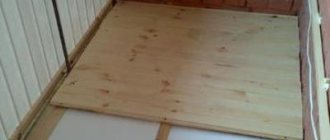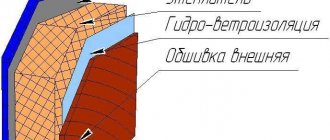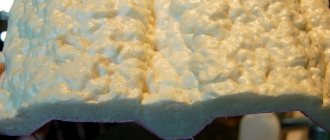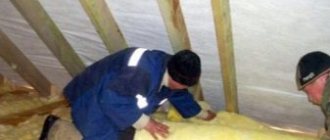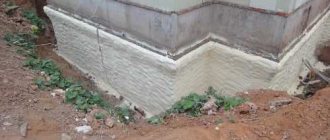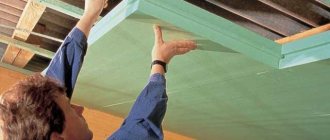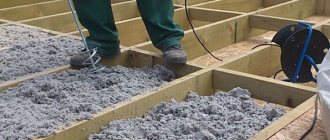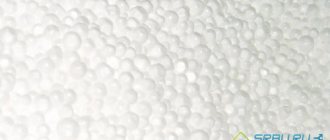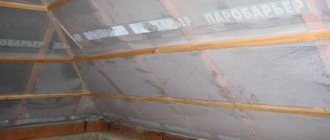What is construction polyurethane foam?
In comparison with elastic compounds of polyols foamed with air and/or carbon dioxide (foam rubber), construction polyurethane foam is a rigid material with a density of 30 - 150 kg/m³. However, it is not rigidity that is the main difference between insulating polyurethane foam and foam rubber, but the structure of its pores. In construction foam, up to 98% of the pores are closed, so the material does not absorb water and conducts heat poorly (due to the gas filling of the chambers - the pores).
Polyurethane foam - a new generation of insulation
Polyurethane foam, sold in spray cans, also belongs to insulating polyurethane foams, but its percentage of closed pores is lower (about 80%). In general, the higher this indicator, the higher the energy efficiency of the insulation. Polyurethane foam has the lowest thermal conductivity coefficient among all insulators currently used in construction. For the best two-component systems, the parameter value does not exceed 0.019 - 0.021 W/m*K. This is 30% less than samples of high-quality extruded polystyrene foam (EPS), which have a coefficient of 0.028 W/m*K.
Polyurethane foam is a material with stable properties. Its characteristics have not changed for many decades. However, it is destroyed when exposed to ultraviolet radiation, so it requires protection from it. The minimum required protection can be achieved with conventional painting.
Disadvantages of polyurethane foam
Despite all its advantages, polyurethane foam also has a number of disadvantages. The main one is the ability to decompose under the influence of UV rays of sunlight. Therefore, insulation applied to the surface requires insulation from direct sunlight as quickly as possible. Polyurethane foam itself is not a breeding ground for the development of mold. But nothing prevents the development of mold on the surface of polyurethane foam (especially open-cell foam) in damp, cold rooms.
Polyurethane foam is not an insurmountable barrier for rats and mice. In itself, it is not nutritious and mice will not eat it, but for the purpose of making moves, this material does not pose any obstacle for rodents.
Rodents do not settle in closed-cell polyurethane foam, since air and vapor exchange are difficult in it, but in open-cell polyurethane foam they are happy to make “nests” for themselves.
The biggest disadvantage is the complexity of application and the mandatory presence of special equipment. Even buying or renting a machine for applying polyurethane foam does not guarantee high-quality work on insulating the attic from the inside with your own hands. Applying liquid insulation requires knowledge of drawing up the correct proportions of components, selecting working pressure, forming a jet of working solution and observing a number of other nuances that are familiar only to specialists working with this equipment.
Therefore, it is not advisable to independently carry out work on insulating the attic with polyurethane foam. And the work of a team of 2-3 people for 2-3 days to insulate the surfaces of an attic of 100 m2 completely “eats up” the benefits of the speed of applying insulation.
Advantages of attic insulation using polyurethane foam
In domestic practice, insulating an attic with PPU is more expensive than insulating it with EPS or mineral wool. Perhaps this is the only reason why polyurethane foam is still inferior in popularity to two cheaper materials. However, in a number of high-wage countries (for example, the USA and Canada), spray foam technologies have come out on top. Why did this happen? Firstly, the cost of any construction operation consists of the price of the material and relative labor costs, which for polyurethane foam are among the lowest. Secondly, urethane foam has a number of properties that put it beyond competition with other insulation materials:
PPU is an effective solution for sound absorption
- Record energy efficiency. In terms of insulating characteristics, it is second only to aerogels, which still have a long way to go from the world of high-tech to a real construction site.
- Stability of sealing properties. Cold bridges do not form even during prolonged use.
- Manufacturability.
- Relatively small layer of insulation.
- Effective sound absorption.
- Higher fire resistance than XPS.
Certain points deserve detailed consideration.
Stability of sealing properties
The main advantage of polyurethane foam over any slab insulation is not even its record low thermal conductivity, but the absence of the slightest cold bridges. Moreover, this property remains stable throughout the entire service life (several decades).
The combination of slabs with sealing seams using polyurethane foam in some cases creates defects in the form of gaps between the insulator and the surface of the rafter beams.
PPU tightly fills all the cracks of the roof structure
When temperature and humidity fluctuate, the wood becomes deformed, and sometimes it “comes off” from the insulation board, forming cracks. These cracks become areas of condensation formation with the formation of cold bridges and a decrease in the service life of wooden structures. The application of polyurethane foam ensures that the insulating properties of the coating are maintained uniformly over the entire area without the formation of leaks. Thermal imaging studies of new and long-term insulations confirm this.
Issues of fire safety and environmental friendliness of coating
Polyurethane foam belongs to the fire-hazardous self-extinguishing materials of group G2, like a number of types of EPS, but can withstand higher temperatures (up to 150 ° C). Polyurethane foam without the addition of fire retardants is 6 times less flammable than wooden rafter structures.
With fire retardants, polyurethane foam can be completely fireproof. But in this case, a number of experts do not recommend its use for internal insulation due to the possible emission of chloride compounds, which can lead to allergic reactions.
PU foam is less flammable than wood
In the US and Canada, where flame retardant foam insulation is extremely common, there have been isolated cases of homeowners having to remove flame retardant polyurethane foam insulation due to allergies.
The fire protection standard for steel interfloor ceilings deserves special mention. In a fire, steel does not burn, but when heated, it loses its strength properties. Therefore, beams and trusses, if necessary, are covered with polyurethane foam pulp with modifying additives, which protects their material from heating.
Manufacturability
Insulation of the attic with polyurethane foam is possible in 1 day
The work is carried out quickly, and the complexity of the terrain being covered is not of decisive importance. For this reason, the application of polyurethane foam is usually used to insulate roof structures of restored objects of historical significance. In one shift, two operators efficiently process up to 200 m² of under-roof space.
Reducing insulation thickness
At the same level of energy efficiency, the thickness of the foam spray is 30% less than the thickness of insulation made of EPS and 50% less than the required layer of mineral wool. In some cases (with insufficient living space in attics), this criterion may be of decisive importance.
Foam application technology
A cladding made of OSB boards or plank flooring is mounted on top of the rafter beams. The flooring can be made not continuous, but with intervals of 15 - 20 cm between the boards in the case of using roofing cladding with its own stiffeners - for example, metal tiles. A waterproofing membrane must be laid on top of the flooring under the tiles.
PPU attic insulation scheme
No special preparatory treatments are required before applying polyurethane foam. It is only important to make sure that the surface is dry and not contaminated with oily liquids. It should be taken into account that the only materials to which polyurethane foam does not stick are polyethylene and fluoroplastic. The working material is delivered to the site in barrels marked as “component A” and “component B”. Operators and the equipment they use must ensure:
- The temperature of the treated surface is not lower than + 10 °C.
- Preheating of components to temperatures specified in the specifications for a specific material
- Mixing the components in a strict proportion of 1: 1. Even a slight predominance of component A makes the insulation softer and reduces its thermal resistance. In addition, such material does not last more than 20 years. The predominance of component B makes polyurethane foam brittle and also reduces its energy efficiency, although to a lesser extent.
- Efficiency of intensive mixing of components. Only in this case the components react 100%, ensuring the quality and durability of the insulation. Such mixing is guaranteed only by expensive high-pressure units (at least 140 atm.)
- Uniformity of the sprayed layer and its required thickness. Since the material expands during polymerization, only the practical experience of operators allows it to maintain the required thickness in all areas of the coating.
Insulation technology
Unlike insulating an attic space from the inside with mineral wool, before applying polyurethane foam, there is no need to carry out preliminary waterproofing using expensive vapor-permeable membranes and films.
Polyurethane foam is applied directly to the insulated surface. It has excellent adhesion (stickability) to almost any known building materials (with the exception of polyethylene and galvanized metal). In this case, all the slightest joints, cracks, cavities present in the roof structure are completely filled and an absolutely sealed internal (or external) layer is created, completely eliminating the penetration of moisture or freezing.
Typically, polyurethane foam is filled from the inside between the rafter spaces, and the thickness of the filling should not exceed the thickness of the rafters, so that there is a gap of 15-20 mm between the layer of insulation (polyurethane foam) and the decorative coating (plasterboard, laminate plywood, PVC panels). for ventilation.
The use of polyurethane foam when insulating an attic allows you to apply layers of varying thicknesses to various surfaces, which guarantee sufficient insulation, and at the same time, save insulation from excessive application. The second option is to apply polyurethane foam of varying densities to various surfaces.
Before applying polyurethane foam, the only preparatory operation is to remove dust from the structure. Layers of polyurethane foam are applied from the nozzle of the apparatus in uniform horizontal stripes with a layer thickness of 10 mm in 1 pass. To insulate the attic, exclusively closed-cell grades of polyurethane foam are used, which do not absorb moisture.
Features of equipment for spraying polyurethane foam
The high pressure unit includes:
- A generator, usually powered by a diesel engine.
- Compressor.
- Feed pumps (each component has its own pump).
- The central unit, called the dispenser. The uniform supply of both PU foam components, as well as maintaining the required temperature, depends on it. The unit control unit is installed on the dispenser.
- Spray gun and hoses. The hoses from the compressor to the supply pumps are called supply, and the connecting pumps to the dispenser are called recirculation. The gun also comes with 2 hoses, combined into a common sleeve for ease of use. Direct mixing of the components occurs in the gun.
- Personal protective equipment, which includes a special suit and a respirator. Sometimes the respirator is made in the form of an insulating helmet.
Types of PPU installations
In addition to stable operation and strict maintenance of operating parameters, a good installation should provide protection against bypass resulting in material loss. The cost of equipment that provides high-quality PU foam coating, depending on productivity, ranges from 200 to 800 thousand rubles.
We insulate the attic with polyurethane foam in Lipetsk.
Attic floors are the boundary between warm indoor air and cold outdoor air. An attic with poor-quality thermal insulation or without it at all becomes the culprit for heat loss in the house. In addition, constant condensation gradually destroys the ceilings. And in the rooms the ceiling becomes damp and mold appears.
Of course, it's not just a cold attic. Windows, doors, thin walls with high thermal conductivity also affect the temperature in the room. Therefore, a competent approach to home insulation is comprehensive. And one of the stages is insulating the attic.
Of the modern materials, polyurethane foam (PPU) has proven itself to be the most versatile insulation in the climate of Lipetsk. This is a two-component foam based on polyol and isocyanate. It is applied by spraying onto the surface using compact high-precision equipment.
- Environmental safety and biological neutrality confirmed by quality certificates.
- Fire safety. Polyurethane foam is a self-extinguishing material.
- Service life 25-30 years.
- Minimal vapor and water absorption makes it possible to save on waterproofing the attic during construction. And it guarantees the absence of roof leaks after internal insulation.
- Frost resistance of the material and resistance to high temperatures.
- To ensure high-quality thermal insulation, a spray thickness of only 5-6 cm is sufficient.
- It hardens quickly and is easy to apply. On average, 350 m2 of area is closed per shift. That is, it is quite possible to insulate the attic of an average house in 1-2 days.
The simplest option for thermal insulation work in the attic of a house. Internal thermal insulation is done at any time of the year, the only condition is that the air temperature in the room does not fall below +5 degrees. For comfort and speed up work, heat guns are used.
Spraying is applied in an even layer to the cleaned surface. Polyurethane foam has high adhesive properties, so it firmly adheres to any material and follows its relief. Can be applied to any roof slope. The result is a dense, seamless, homogeneous block.
PPU covers the entire surface of the attic: floors, rafter system, roof from the inside. Due to the monolithic nature of the block, the likelihood of heat leakage through cracks is reduced to a minimum.
The low density and light weight of polyurethane foam do not put stress on the roofing system, which is why Polymer Trade is also used for frame buildings.
Thermal insulation by spraying polyurethane foam is performed quickly. This is due to the characteristics of the material. After spraying, it hardens within 3-7 seconds. Therefore, the quality of execution directly depends on the qualifications of the performers. Our company “Polymer Trade” in Lipetsk has professional installers who undergo training. And they are fluent in the technique of polyurethane foam insulation.
Leave a request on our website and receive a detailed free consultation about the material and methods of insulating your home. We will select the most advantageous thermal insulation option taking into account our climate.
Call now and get a warm home in the shortest possible time!
Source: https://lipetsk.ppu-penopoliuretan.ru/services/uteplenie-cherdaka/
Operating practice and reviews from owners of attics insulated with polyurethane foam
The very first roofs insulated with polyurethane foam have been in use in Germany for more than 50 years. Since then, the energy efficiency of the coating has decreased slightly, but it remains in good working order.
The experience of insulating attics using sprayed polyurethane foam contains both positive and negative examples of the use of technology. The study of statistics allowed us to draw an important conclusion: wooden rafter structures insulated with polyurethane foam require measures to limit the flow of moisture into them and ensure sufficient ventilation.
Let us next consider an illustrative case from the recent practice of private housing construction.
A resident of a holiday village located in a forest area in the suburbs of Kyiv operated the building without finishing the interior. After 2 years, he noticed the darkening of the lower surface of the rafters. And in some places there was even mold. After dismantling the polyurethane foam, it turned out that the entire surface of the wooden structures had suffered from waterlogging.
This information quickly spread throughout the village, and homeowners who used polyurethane foam to insulate walls and attic floors immediately began inspecting their buildings. It turned out that several more dachas were damaged in a similar way. However, at other objects, an external examination of the surface of the rafters showed their normal condition. What's the matter? After all, the same materials were used in similar structures located in the same place. It soon became clear that the cause of moisture condensation on the tree was non-compliance with 2 important points during construction:
Strict adherence to the rules for applying thermal insulation is necessary
- There was no vapor barrier layer on the attic side. Steam penetrated freely to the lower surface of the rafters.
- On the roof side, the waterproofing membrane covered the boardwalk without a gap, which is normal when using mineral wool, but is contraindicated in combination with polyurethane foam. The upper surface of the rafters should be blown by air circulating under the roof deck.
Insulation of a cold attic, floors, roof
Tekhmashstroy Group of Companies offers owners of dachas and cottages a rational way to reduce unnecessary heat loss, optimize heating costs and create additional comfort - order insulation of a cold attic from our company. We are ready to insulate your attic using modern material – polyurethane foam.
Why and how do you insulate the attic?
In private homes, up to 50-60% of heat loss occurs through the attic. This is explained simply: on the one hand, there is a significant wind load on it and the heat is blown out, and on the other hand, little attention is paid to the insulation and thermal protection of attic spaces.
Polyurethane foam is excellent for thermal insulation and attic insulation. Its use makes it possible to create a reliable barrier against cold bridges with minimal expenditure of money, time and effort.
In construction practice, other methods of thermal insulation are used. Of the most common, it is worth noting: the use of mineral wool, polystyrene foam, expanded clay or sawdust.
But they have several major disadvantages. This is the need to carry out a significant amount of preparatory work for insulating the attics of houses; heavy weight, increasing the load on the floors; exposure to the external environment; limited period of operation. Insulation with modern plastics does not have these disadvantages.
Reasons to choose PPU attic insulation:
- Insulating an attic in a private house with polyurethane foam requires a minimal amount of work. The base mixture is prepared directly on site. Its layer is easily applied to surfaces made of any materials and, when hardened, adheres to them. The adhesion force is so significant that there is no need for additional fasteners.
- Due to the low thermal conductivity coefficient, a thin layer of polyurethane foam is required to create high-quality thermal insulation. This saves attic space. Taking into account the small mass, such insulation of the attic roof creates a minimal load on the supporting structures.
- Insulating the attic floor with a layer of polyurethane foam can be used in almost any temperature and humidity range. The material is completely inert and does not decompose. The only thing that is needed is external painting to protect against UV rays.
- The estimated service life of polyurethane foam thermal insulation is 30 years. Analogs last much less.
- By choosing PPU attic insulation, you can forget about mold and fungi. The material is not susceptible to them. Rodents, cockroaches and other insects are also indifferent to this plastic.
- This plastic can be used to cover not only horizontal surfaces. Polyurethane foam is an excellent solution for insulating the floors and roofs of a cold attic. It is worth noting that after hardening, the plastic works as an additional reinforcing frame.
Thermal insulation of the attic with polyurethane foam in the Tekhmashstroy Group of Companies
The cost of insulating an attic using such thermal insulation is made up not only of the price of materials, but also of the necessary work. If you make specific calculations, it becomes obvious that the price for such attic insulation is the most affordable and will quickly pay off.
| Name of works | Insulation thickness, mm | Cost per 1 m2, rubles including VAT |
| Sprayed polyurethane foam, core density 8-12 kg/m3, open cell. (material Elastospray 1601/15, BASF) | 50 | 450 |
| 100 | 650 | |
| 150 | 900 | |
| 200 | 1200 | |
| Sprayed polyurethane foam, core density 30-35 kg/m3, closed cell. (material Elastospray 1622/39, BASF) | 30 | 570 |
| 50 | 950 | |
| 80 | negotiable | |
| 100 | negotiable | |
| Work on pouring polyurethane foam into a cavity, open cell density 8-12 kg/m3. (material Elastopor H2401/100, BASF) | from 9500 rub/m3 | |
| Work on pouring polyurethane foam into the cavity, closed cell density 40 kg/m3. (material Elastopor H1701/20, BASF) | From 16,000 rub/m3 |
GC "Tehmashstroy" has been producing polyurethane foam and complex insulation of attics of houses and their roofs for 19 years. During this time, the company’s specialists have perfected thermal insulation technology down to the smallest nuances and implemented projects of varying complexity.
If you need warmth and comfort in your own home, contact our managers. They will provide comprehensive information, prepare a project and estimate, place an order and ensure its perfect implementation.
Source: https://www.rpsk.ru/services/uteplenie-cherdaka/
